Investigating the Potential Impact of IoT on the Construction Industry
VerifiedAdded on 2023/06/05
|7
|1279
|64
Report
AI Summary
This report investigates the transformative potential of the Internet of Things (IoT) within the construction industry. It explores how IoT applications, such as RFID tags, can revolutionize supply replenishment, enabling remote usage monitoring, and optimizing equipment tracking. The report discusses the benefits of automation and its impact on productivity, cost reduction, and worker safety. It analyzes the ethical considerations associated with IoT adoption, emphasizing the need for stakeholder approval and the importance of robust central systems. The report also utilizes BPMN events to illustrate supply and resupply processes, highlighting the advantages of RFID tags in real-time inventory management and the ability to notify executives of low supply levels. Through research and brainstorming, the report concludes that the integration of IoT technologies will significantly enhance efficiency and decision-making in construction projects.
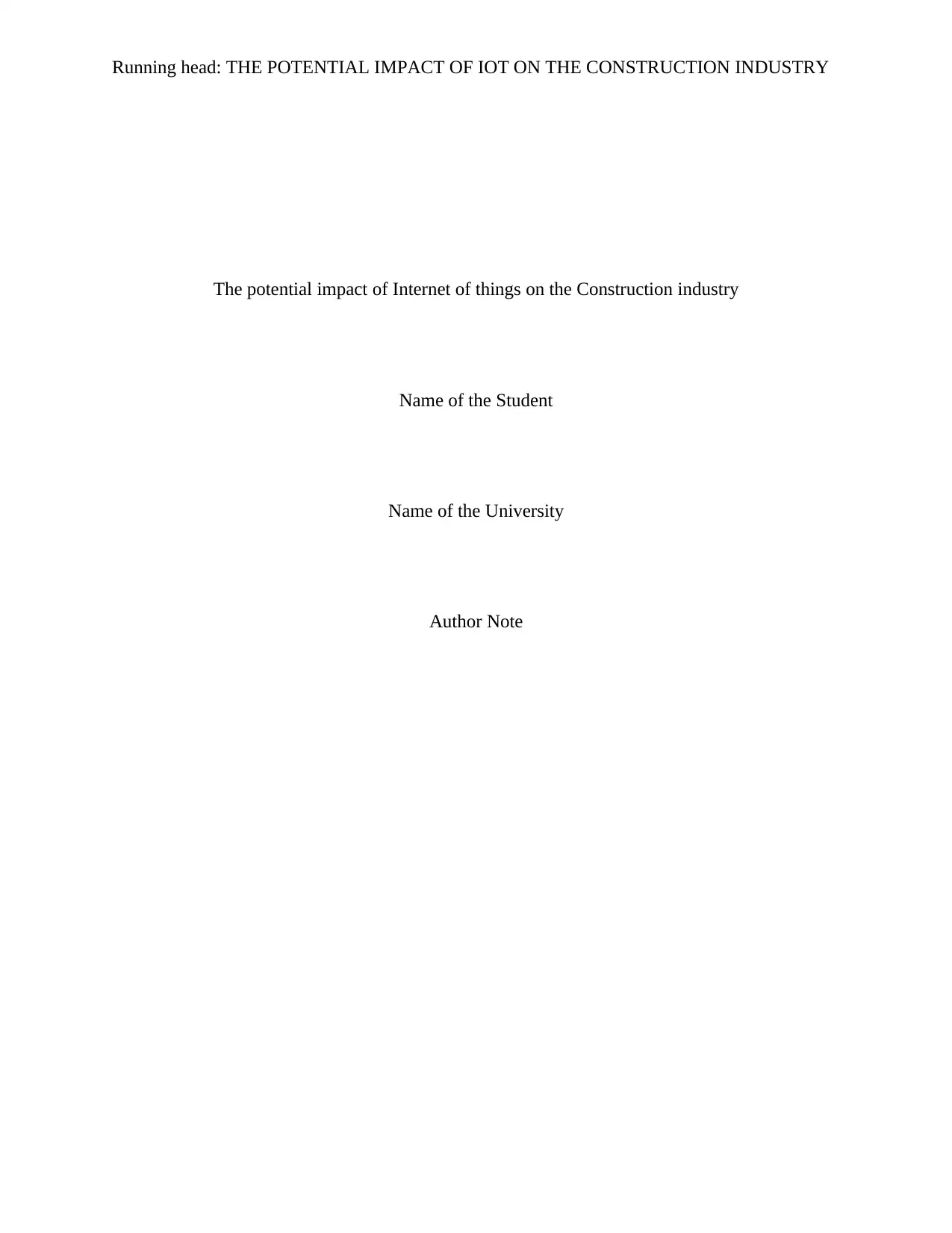
Running head: THE POTENTIAL IMPACT OF IOT ON THE CONSTRUCTION INDUSTRY
The potential impact of Internet of things on the Construction industry
Name of the Student
Name of the University
Author Note
The potential impact of Internet of things on the Construction industry
Name of the Student
Name of the University
Author Note
Paraphrase This Document
Need a fresh take? Get an instant paraphrase of this document with our AI Paraphraser
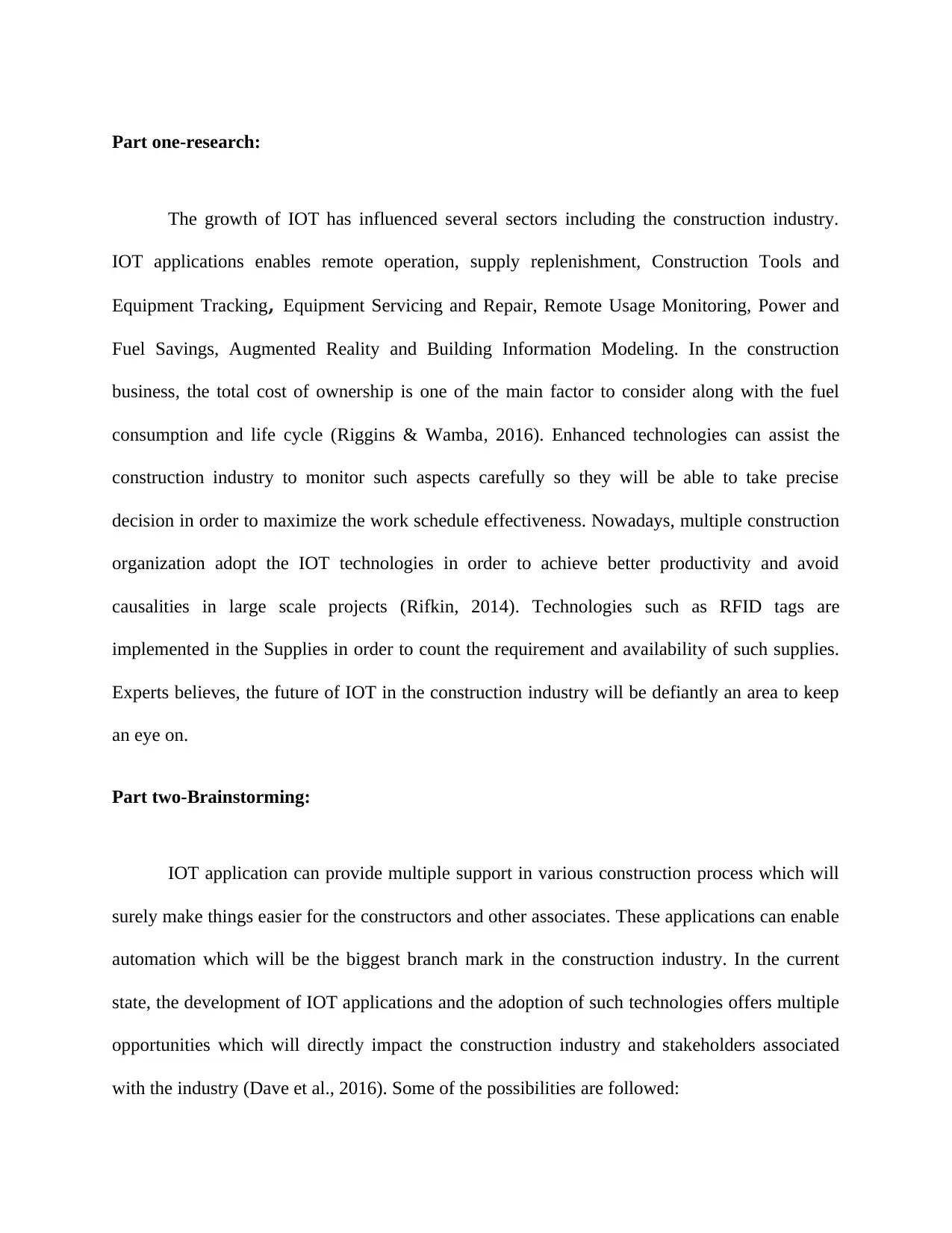
Part one-research:
The growth of IOT has influenced several sectors including the construction industry.
IOT applications enables remote operation, supply replenishment, Construction Tools and
Equipment Tracking, Equipment Servicing and Repair, Remote Usage Monitoring, Power and
Fuel Savings, Augmented Reality and Building Information Modeling. In the construction
business, the total cost of ownership is one of the main factor to consider along with the fuel
consumption and life cycle (Riggins & Wamba, 2016). Enhanced technologies can assist the
construction industry to monitor such aspects carefully so they will be able to take precise
decision in order to maximize the work schedule effectiveness. Nowadays, multiple construction
organization adopt the IOT technologies in order to achieve better productivity and avoid
causalities in large scale projects (Rifkin, 2014). Technologies such as RFID tags are
implemented in the Supplies in order to count the requirement and availability of such supplies.
Experts believes, the future of IOT in the construction industry will be defiantly an area to keep
an eye on.
Part two-Brainstorming:
IOT application can provide multiple support in various construction process which will
surely make things easier for the constructors and other associates. These applications can enable
automation which will be the biggest branch mark in the construction industry. In the current
state, the development of IOT applications and the adoption of such technologies offers multiple
opportunities which will directly impact the construction industry and stakeholders associated
with the industry (Dave et al., 2016). Some of the possibilities are followed:
The growth of IOT has influenced several sectors including the construction industry.
IOT applications enables remote operation, supply replenishment, Construction Tools and
Equipment Tracking, Equipment Servicing and Repair, Remote Usage Monitoring, Power and
Fuel Savings, Augmented Reality and Building Information Modeling. In the construction
business, the total cost of ownership is one of the main factor to consider along with the fuel
consumption and life cycle (Riggins & Wamba, 2016). Enhanced technologies can assist the
construction industry to monitor such aspects carefully so they will be able to take precise
decision in order to maximize the work schedule effectiveness. Nowadays, multiple construction
organization adopt the IOT technologies in order to achieve better productivity and avoid
causalities in large scale projects (Rifkin, 2014). Technologies such as RFID tags are
implemented in the Supplies in order to count the requirement and availability of such supplies.
Experts believes, the future of IOT in the construction industry will be defiantly an area to keep
an eye on.
Part two-Brainstorming:
IOT application can provide multiple support in various construction process which will
surely make things easier for the constructors and other associates. These applications can enable
automation which will be the biggest branch mark in the construction industry. In the current
state, the development of IOT applications and the adoption of such technologies offers multiple
opportunities which will directly impact the construction industry and stakeholders associated
with the industry (Dave et al., 2016). Some of the possibilities are followed:
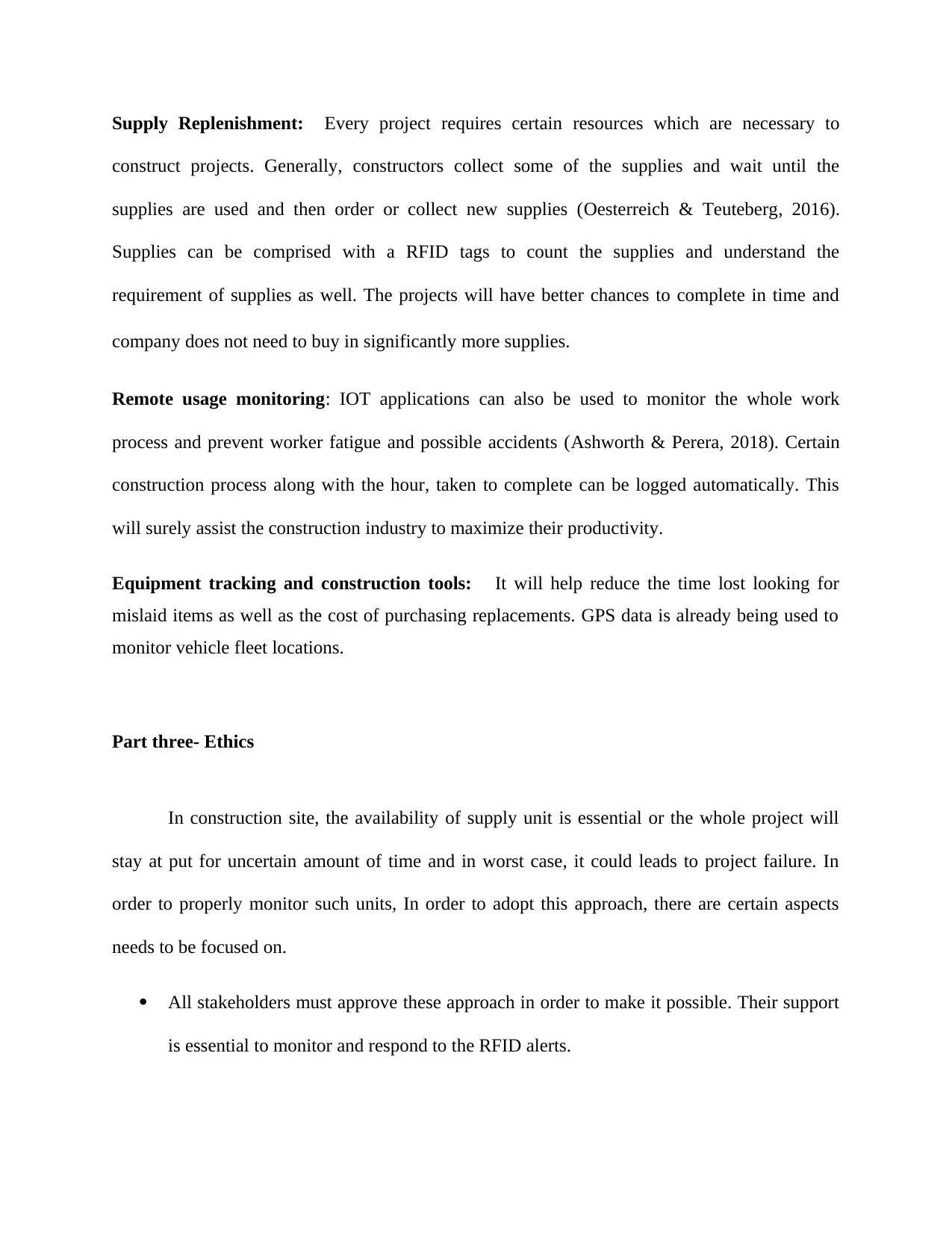
Supply Replenishment: Every project requires certain resources which are necessary to
construct projects. Generally, constructors collect some of the supplies and wait until the
supplies are used and then order or collect new supplies (Oesterreich & Teuteberg, 2016).
Supplies can be comprised with a RFID tags to count the supplies and understand the
requirement of supplies as well. The projects will have better chances to complete in time and
company does not need to buy in significantly more supplies.
Remote usage monitoring: IOT applications can also be used to monitor the whole work
process and prevent worker fatigue and possible accidents (Ashworth & Perera, 2018). Certain
construction process along with the hour, taken to complete can be logged automatically. This
will surely assist the construction industry to maximize their productivity.
Equipment tracking and construction tools: It will help reduce the time lost looking for
mislaid items as well as the cost of purchasing replacements. GPS data is already being used to
monitor vehicle fleet locations.
Part three- Ethics
In construction site, the availability of supply unit is essential or the whole project will
stay at put for uncertain amount of time and in worst case, it could leads to project failure. In
order to properly monitor such units, In order to adopt this approach, there are certain aspects
needs to be focused on.
All stakeholders must approve these approach in order to make it possible. Their support
is essential to monitor and respond to the RFID alerts.
construct projects. Generally, constructors collect some of the supplies and wait until the
supplies are used and then order or collect new supplies (Oesterreich & Teuteberg, 2016).
Supplies can be comprised with a RFID tags to count the supplies and understand the
requirement of supplies as well. The projects will have better chances to complete in time and
company does not need to buy in significantly more supplies.
Remote usage monitoring: IOT applications can also be used to monitor the whole work
process and prevent worker fatigue and possible accidents (Ashworth & Perera, 2018). Certain
construction process along with the hour, taken to complete can be logged automatically. This
will surely assist the construction industry to maximize their productivity.
Equipment tracking and construction tools: It will help reduce the time lost looking for
mislaid items as well as the cost of purchasing replacements. GPS data is already being used to
monitor vehicle fleet locations.
Part three- Ethics
In construction site, the availability of supply unit is essential or the whole project will
stay at put for uncertain amount of time and in worst case, it could leads to project failure. In
order to properly monitor such units, In order to adopt this approach, there are certain aspects
needs to be focused on.
All stakeholders must approve these approach in order to make it possible. Their support
is essential to monitor and respond to the RFID alerts.
⊘ This is a preview!⊘
Do you want full access?
Subscribe today to unlock all pages.

Trusted by 1+ million students worldwide
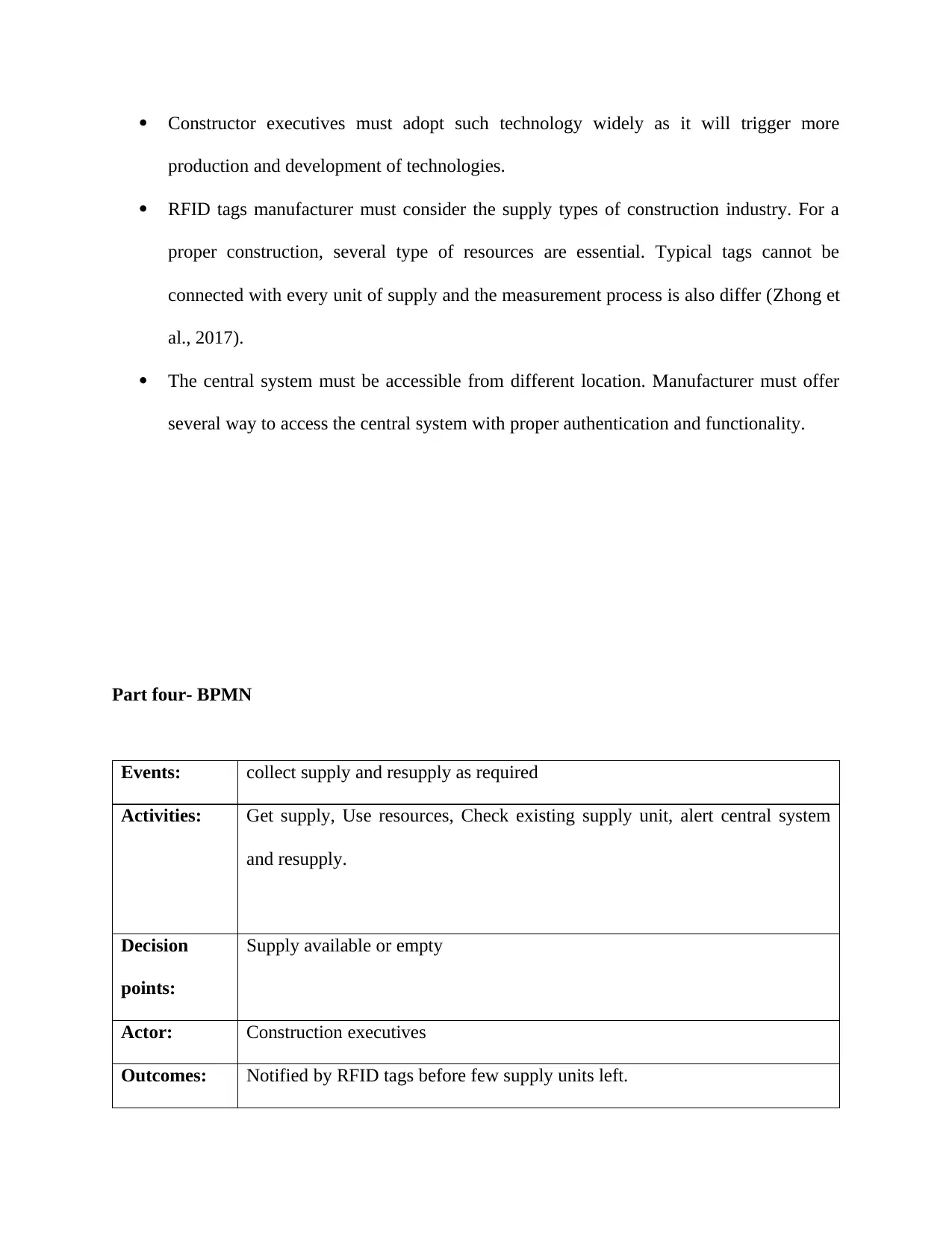
Constructor executives must adopt such technology widely as it will trigger more
production and development of technologies.
RFID tags manufacturer must consider the supply types of construction industry. For a
proper construction, several type of resources are essential. Typical tags cannot be
connected with every unit of supply and the measurement process is also differ (Zhong et
al., 2017).
The central system must be accessible from different location. Manufacturer must offer
several way to access the central system with proper authentication and functionality.
Part four- BPMN
Events: collect supply and resupply as required
Activities: Get supply, Use resources, Check existing supply unit, alert central system
and resupply.
Decision
points:
Supply available or empty
Actor: Construction executives
Outcomes: Notified by RFID tags before few supply units left.
production and development of technologies.
RFID tags manufacturer must consider the supply types of construction industry. For a
proper construction, several type of resources are essential. Typical tags cannot be
connected with every unit of supply and the measurement process is also differ (Zhong et
al., 2017).
The central system must be accessible from different location. Manufacturer must offer
several way to access the central system with proper authentication and functionality.
Part four- BPMN
Events: collect supply and resupply as required
Activities: Get supply, Use resources, Check existing supply unit, alert central system
and resupply.
Decision
points:
Supply available or empty
Actor: Construction executives
Outcomes: Notified by RFID tags before few supply units left.
Paraphrase This Document
Need a fresh take? Get an instant paraphrase of this document with our AI Paraphraser
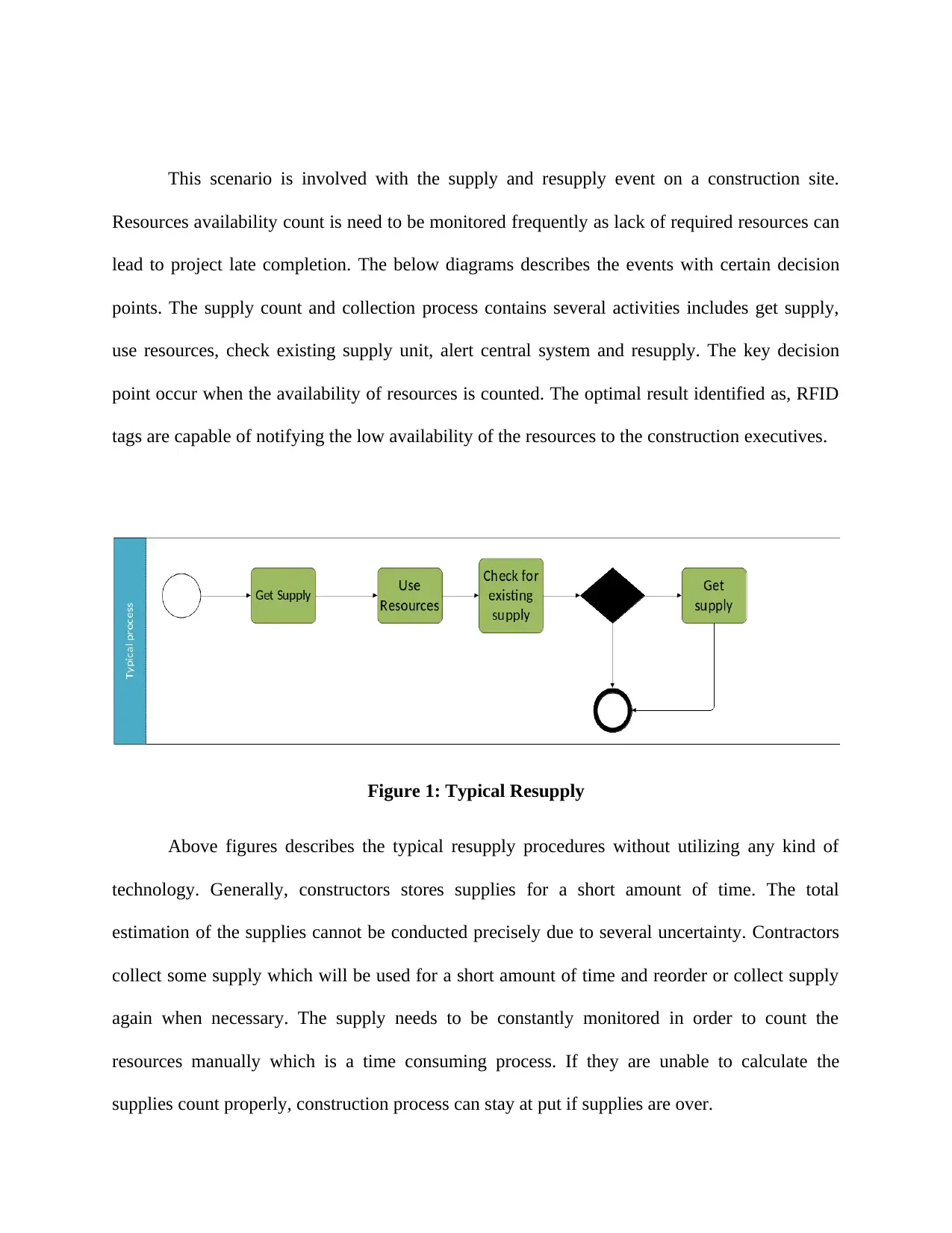
This scenario is involved with the supply and resupply event on a construction site.
Resources availability count is need to be monitored frequently as lack of required resources can
lead to project late completion. The below diagrams describes the events with certain decision
points. The supply count and collection process contains several activities includes get supply,
use resources, check existing supply unit, alert central system and resupply. The key decision
point occur when the availability of resources is counted. The optimal result identified as, RFID
tags are capable of notifying the low availability of the resources to the construction executives.
Figure 1: Typical Resupply
Above figures describes the typical resupply procedures without utilizing any kind of
technology. Generally, constructors stores supplies for a short amount of time. The total
estimation of the supplies cannot be conducted precisely due to several uncertainty. Contractors
collect some supply which will be used for a short amount of time and reorder or collect supply
again when necessary. The supply needs to be constantly monitored in order to count the
resources manually which is a time consuming process. If they are unable to calculate the
supplies count properly, construction process can stay at put if supplies are over.
Resources availability count is need to be monitored frequently as lack of required resources can
lead to project late completion. The below diagrams describes the events with certain decision
points. The supply count and collection process contains several activities includes get supply,
use resources, check existing supply unit, alert central system and resupply. The key decision
point occur when the availability of resources is counted. The optimal result identified as, RFID
tags are capable of notifying the low availability of the resources to the construction executives.
Figure 1: Typical Resupply
Above figures describes the typical resupply procedures without utilizing any kind of
technology. Generally, constructors stores supplies for a short amount of time. The total
estimation of the supplies cannot be conducted precisely due to several uncertainty. Contractors
collect some supply which will be used for a short amount of time and reorder or collect supply
again when necessary. The supply needs to be constantly monitored in order to count the
resources manually which is a time consuming process. If they are unable to calculate the
supplies count properly, construction process can stay at put if supplies are over.
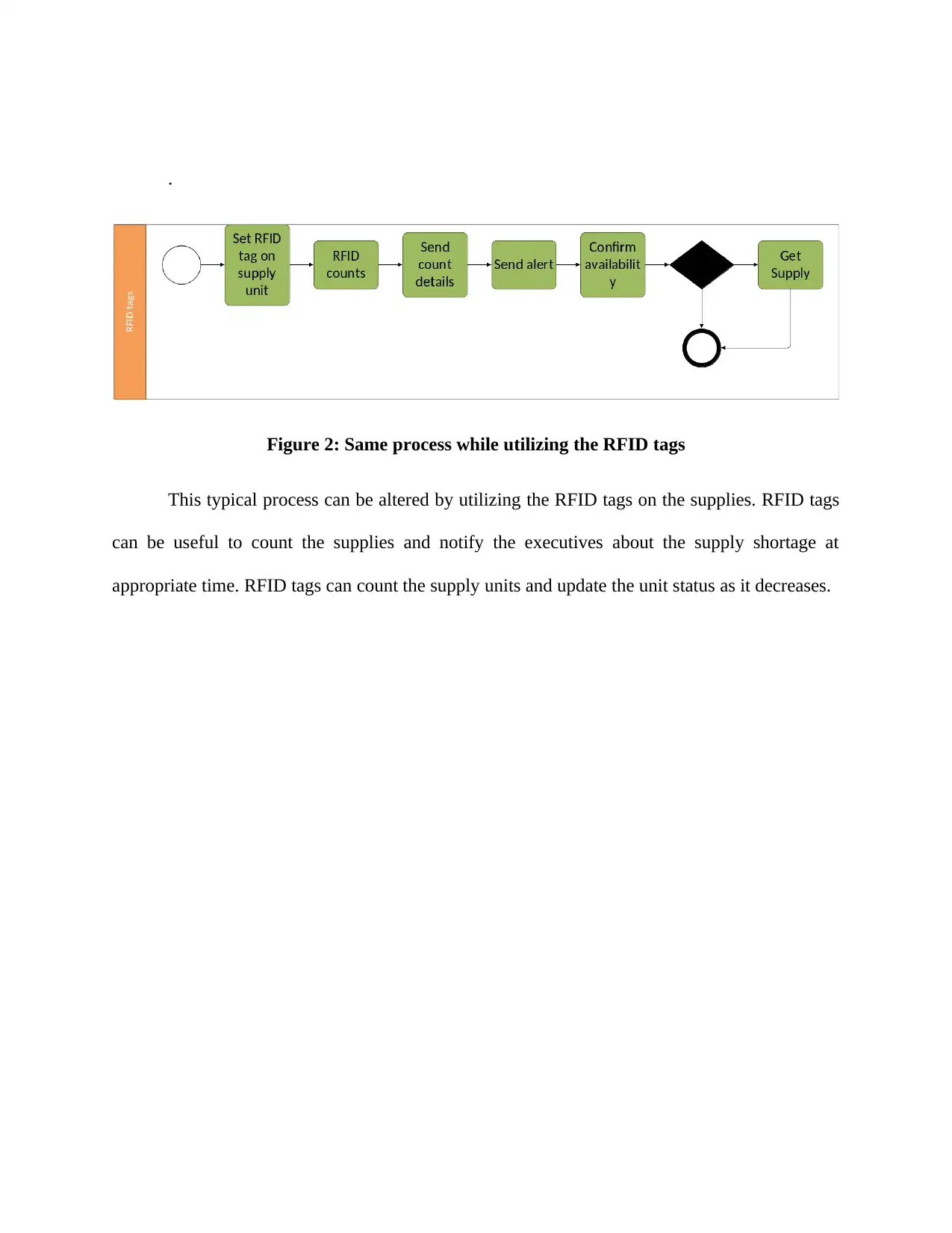
.
Figure 2: Same process while utilizing the RFID tags
This typical process can be altered by utilizing the RFID tags on the supplies. RFID tags
can be useful to count the supplies and notify the executives about the supply shortage at
appropriate time. RFID tags can count the supply units and update the unit status as it decreases.
Figure 2: Same process while utilizing the RFID tags
This typical process can be altered by utilizing the RFID tags on the supplies. RFID tags
can be useful to count the supplies and notify the executives about the supply shortage at
appropriate time. RFID tags can count the supply units and update the unit status as it decreases.
⊘ This is a preview!⊘
Do you want full access?
Subscribe today to unlock all pages.

Trusted by 1+ million students worldwide
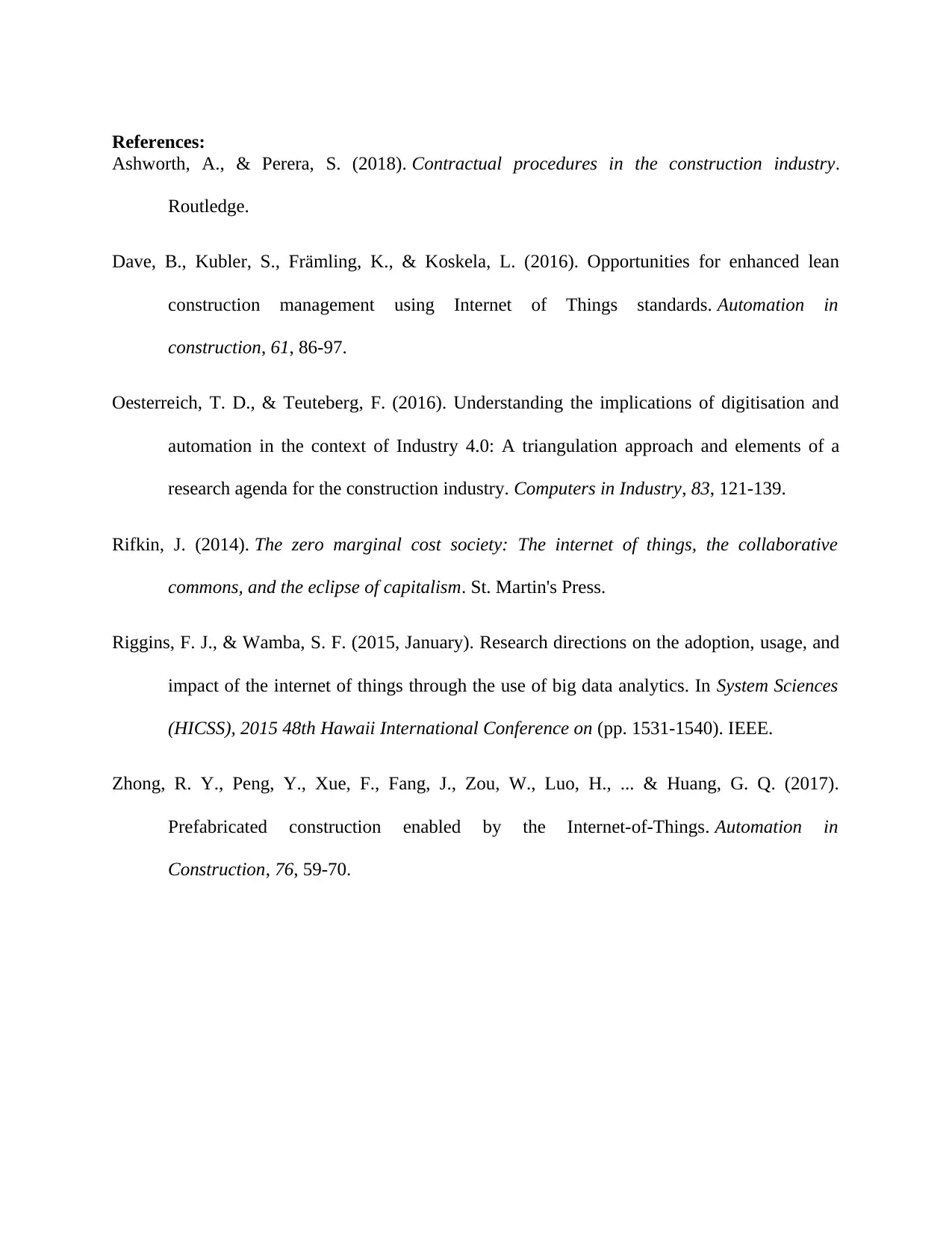
References:
Ashworth, A., & Perera, S. (2018). Contractual procedures in the construction industry.
Routledge.
Dave, B., Kubler, S., Främling, K., & Koskela, L. (2016). Opportunities for enhanced lean
construction management using Internet of Things standards. Automation in
construction, 61, 86-97.
Oesterreich, T. D., & Teuteberg, F. (2016). Understanding the implications of digitisation and
automation in the context of Industry 4.0: A triangulation approach and elements of a
research agenda for the construction industry. Computers in Industry, 83, 121-139.
Rifkin, J. (2014). The zero marginal cost society: The internet of things, the collaborative
commons, and the eclipse of capitalism. St. Martin's Press.
Riggins, F. J., & Wamba, S. F. (2015, January). Research directions on the adoption, usage, and
impact of the internet of things through the use of big data analytics. In System Sciences
(HICSS), 2015 48th Hawaii International Conference on (pp. 1531-1540). IEEE.
Zhong, R. Y., Peng, Y., Xue, F., Fang, J., Zou, W., Luo, H., ... & Huang, G. Q. (2017).
Prefabricated construction enabled by the Internet-of-Things. Automation in
Construction, 76, 59-70.
Ashworth, A., & Perera, S. (2018). Contractual procedures in the construction industry.
Routledge.
Dave, B., Kubler, S., Främling, K., & Koskela, L. (2016). Opportunities for enhanced lean
construction management using Internet of Things standards. Automation in
construction, 61, 86-97.
Oesterreich, T. D., & Teuteberg, F. (2016). Understanding the implications of digitisation and
automation in the context of Industry 4.0: A triangulation approach and elements of a
research agenda for the construction industry. Computers in Industry, 83, 121-139.
Rifkin, J. (2014). The zero marginal cost society: The internet of things, the collaborative
commons, and the eclipse of capitalism. St. Martin's Press.
Riggins, F. J., & Wamba, S. F. (2015, January). Research directions on the adoption, usage, and
impact of the internet of things through the use of big data analytics. In System Sciences
(HICSS), 2015 48th Hawaii International Conference on (pp. 1531-1540). IEEE.
Zhong, R. Y., Peng, Y., Xue, F., Fang, J., Zou, W., Luo, H., ... & Huang, G. Q. (2017).
Prefabricated construction enabled by the Internet-of-Things. Automation in
Construction, 76, 59-70.
1 out of 7
Related Documents
Your All-in-One AI-Powered Toolkit for Academic Success.
+13062052269
info@desklib.com
Available 24*7 on WhatsApp / Email
![[object Object]](/_next/static/media/star-bottom.7253800d.svg)
Unlock your academic potential
Copyright © 2020–2025 A2Z Services. All Rights Reserved. Developed and managed by ZUCOL.




